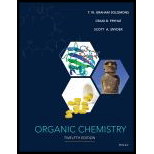
Concept explainers
Interpretation:
The products of the given acid–base reactions are to be predicted and, in each case, the stronger acid, the stronger base, the weaker acid, and the weaker base are to be labeled.
Concept introduction:
Substitution reaction: A reaction in which one of the hydrogen atoms of a hydrocarbon, or a
Elimination reaction: A reaction in which two substituent groups are detached and a double bond is formed is called elimination reaction.
Addition reaction: It is the reaction in which unsaturated bonds are converted to saturated molecules by addition of molecules.
Sodium amide is a strong base that helps in the removal of terminal hydrogen of
Want to see the full answer?
Check out a sample textbook solution
Chapter 7 Solutions
EBK ORGANIC CHEMISTRY
- For the Brønsted acid-base reaction shown below, determine the conjugate acid- base pairs. Then give the curved-arrow notation for the reaction in the left-to-right direction :0: :O: Нзс- H–Ö-H -> Нзс A D Fill in the blanks with the letters A,B,C, and D, representing the species in the reaction above. (It doesn't matter which pair you list first.) Pair 1: Pair 2: acid and its conjugate base acid and its conjugate basearrow_forward6. Predict the products of the following acid-base reactions, and predict whether the equilibrium lies to the left or to the right of the reaction arrow: (a) O2-(aq) + H2O(1)<---> (b) CH3COOH(aq) + HS-(aq)<---> (c) NO2-(aq) + H2O(1)<---> Group of answer choices A.) (a) 2 OH-; 100% to products (b) CH3COO- + H2S; towards products (c) HNO2 + OH-; towards reactants B.) (a) 2 OH-; 100% to products (b) CH3COO- + H2S; 100% to products (c) HNO2 + OH-; towards reactants C.) (a) 2 OH-; 100% to products (b) CH3COO- + H2S; towards products (c) HNO2 + OH-; towards products D.) (a) 2 OH-; towards reactants (b) CH3COO- + H2S; towards products (c) HNO2 + OH-; towards reactantsarrow_forward7. 2 Cro2?(aq) + 2 H* (aq) = CrO² (aq) + H2O Yellow AH° =-14 kJ/mol Orange Consider the equilibrium given above and predict the direction that the equilibrium will shift upon the (a) Addition of HCI (aq). Give reasons for your prediction. (b) Addition of NaOH(aq). Give reasons for your prediction. (c) Addition of BaCl2(aq). Give reasons for your prediction. (d) Temperature rise. Give reasons for your prediction.arrow_forward
- (a) Predict the products of the following acid-base reactions using curved-arrow mechanisms to indicate electron flow. (b) Indicate the acid, base, conjugate acid, and conjugate base of each reaction. (c) Indicate whether the reactants or products are favored at equilibrium a) CH,COOH CH3O b) CH,CH,OH H2Narrow_forward5. One of the key steps in the tricarboxylic acid (TCA) cycle is the hydration of fumarate to malate: Fumarate-² + H₂O = Malate-2 The standard reaction Gibbs free energy and enthalpy for this reactions are -880 cal/mol and 3560 cal/mol, respectively. (a) What is the equilibrium constant for this reaction (25 °C)? (b) Is the reaction favorable (spontaneous) at 25 °C? (c) What is the equilibrium constant of this reaction under physiological conditions (37 °C)? (d) Is this reaction favorable at 37 °C?arrow_forwardConsider the following equilibrium reaction: 2 CH3OH + CH2O ⇌CH2(OCH3)2+ H2O ΔH = + 46 indicate the direction that the equilibrium will shift when the following changes are made.(No states are provided because the solvent for the reaction is not water, so aq for aqueous would not be appropriate.) (a)Concentration of CH3OH increases (b)H2O is removed from the reaction (c)Reaction is heatedarrow_forward
- 1. (a) For each of the Brønsted acid-base reactions shown below, label the conjugate acid-base pairs. (b) Use curved arrows to illustrate electron flow for each reaction going from left to right. H I H-N+-H H CH3 H3C-C-0 CH3 YoY H H OH- OH- H-CI но H-C-S-CI но H I H-N H CH3 H3C-C-OH CH3 T *N+ I H H H YNY H₂O H₂O CI- но H-C=S-CIarrow_forwardWhat is the correct equilibrium constant expression for the following reaction? NH3(aq) + H₂O(NH4+ (aq) + OH(aq) [NH3] [H₂O] [NH4]+[OH]- (A) Kc = (B) K (C) Kc (D) Kc (E) Kc = = = = - [NH₂+] [OH-] [NH3] [NH4+] [OH [NH3] [H₂O] [NH3] [NH4+] [OH [NH₁+]+[OH-] [NH3]arrow_forwardIf the G for a reaction is 4.5 kcal/mol at 298 K, what is the Keq for this reaction? What is the change in entropy of this reaction if H = 3.2 kcal/mol?arrow_forward
- For each of the following pairs or reactions, which is correctly labeled as having the larger equilibrium constant. There may be more than one correct answer. CHон рКа %3D15.5 CHCH2OH pKa =15.9 NH, pKa =9.4 CH;NH pKa =10.7 CH CH OH + NH3 CH OH + NH3 CH;CH20 + NH," CHO + NH, larger Kea CH:CH,OH + CH NH2 CH,CHO + CHNH, larger Keg CH3CH2OH + NH3 CH3CH 0 + NH Туре: MС QUESTION 9 CH-CH3 Name the compound. HC-CH-CH-CH-CH CH CH2CH3 O 2-ethyl-3-propylpentane 4-ethyl-3-methylheptane O 2,3-diethylhexane Save A Click Save and Submit to save and submit. Click Save All Answers to save all answers.arrow_forward5. (a) The molecule shown below can react with a base, and lose one of the five protons to form an anionic intermediate. Draw this anionic intermediate, and explain why that proton is removed instead of one of the others. CI H Cl -H H H Cl (b) The same molecule can react with Ag", and lose one of the three chlorine atoms to form a cationic intermediate. Draw this cationic intermediate, and explain why that chlorine atom is removed, while neither of the other two are removed. CI H Cl -H H H H CIarrow_forward3.27 For each pair of structures below, identify the stronger acid, and explain your choice: H H N=H -N H H H (a) (c) H -" :0 H ΝΞΗ I H ΗΘΗ `N' H CONTA ΘΝ H (b) (d) H H H N H I Harrow_forward
 Organic ChemistryChemistryISBN:9781305580350Author:William H. Brown, Brent L. Iverson, Eric Anslyn, Christopher S. FootePublisher:Cengage Learning
Organic ChemistryChemistryISBN:9781305580350Author:William H. Brown, Brent L. Iverson, Eric Anslyn, Christopher S. FootePublisher:Cengage Learning
